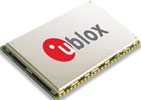

The LEON-G100 and -G200 GSM/GPRS modem modules from u-blox are cost efficient solutions bringing full feature quad band GSM/GPRS data and voice transmission technology in a compact form factor.
Featuring low power consumption and GSM/GPRS class 10 data transmission with voice capability, they combine baseband, RF transceiver, power management unit and power amplifier in a single, easy-to-integrate module.
The modules are complete, fully qualified and certified solutions optimised to work with u-blox’ GPS receivers to support low-cost, mass-market, location-aware applications requiring mobile connectivity such as asset tracking, fleet management, road pricing, vehicle recovery and mobile emergency services such as Europe’s eCall. They are also well suited for use in machine-to-machine telemetry systems for automatic meter reading (AMR), remote monitoring automation and control (RMAC), surveillance and security, anti-theft systems and point of sale (PoS) terminals.
LEON-G100 and LEON G-200 GSM/GPRS modules have been certified by the FCC, IC, PTCRB and R&TTE. LEON has also demonstrated compliance with the Global Certification Forum (GCF) requirements. For customers using u-blox GPS receivers, the modules feature embedded AssistNow Online and AssistNow Offline clients. The AssistNow client is fully implemented on the module, requiring no software integration on an external host microcontroller. Full access to u-blox GPS receivers is available through a dedicated DDC (I2C) interface. This means that GSM/GPRS and GPS can be controlled through a single serial port from any host processor.
Interfaces
The LEON-G100/G200 modules provide four analog and one digital audio interfaces; this includes two microphone inputs and two speaker outputs. Both microphone inputs can be used for direct connection of a handset’s electret condenser microphone. The first speaker output is a single-ended, low power audio output that can be used to directly connect a receiver (earpiece), while the second speaker output is a differential, high power audio output that can be used to directly connect a speaker or a loudspeaker.
An RF antenna interface is implemented by a board-to-board SMD pad with an impedance of 50 Ω. The SIM card interface is provided on the board-to-board pins of the modules; a high-speed SIM/ME interface is implemented, as well as automatic detection of the required SIM supporting voltage. Both 1,8 V and 3 V SIM types are supported. Activation and deactivation with automatic voltage switch from 1,8 V to 3 V are implemented, according to ISO-IEC 7816-3 specifications. The SIM driver supports the PPS (protocol and parameter selection) procedure for baud rate selection.
The integrated UART interface is an 8-wire unbalanced asynchronous serial interface provided for all communications with the LEON-G100/G200 modules, including AT commands, GPRS data and CSD data, as well as software upgrades.
One analog-to-digital converter (ADC) input is available with the LEON-G100 and can be configured via u-blox AT commands. Both modules provide two general purpose input/output (GPIO) pins, also configurable via u AT commands.
The LEON-G100/G200 modules have a software layer with MUX functionality, 3GPP TS 27.010 multiplexer protocol. It is a data link protocol (layer 2 of OSI model) which uses HDLC-like framing and operates between the module (DCE) and the application processor (DTE), and allows a number of simultaneous sessions over the physical link (UART). This permits, for example, SMSs to be transferred to the DTE when a data connection is in progress.
For more information contact Andrew Hutton, RF Design, +27 (0)21 555 8400, [email protected], www.rfdesign.co.za
| Tel: | +27 21 555 8400 |
| Email: | [email protected] |
| www: | www.rfdesign.co.za |
| Articles: | More information and articles about RF Design |
© Technews Publishing (Pty) Ltd | All Rights Reserved